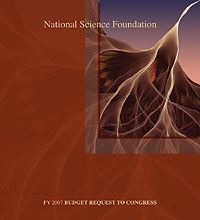
Exponential
Image courtesy of Eric Heller, Harvard University.
In addition to his work as professor of physics and chemistry at Harvard University and National Science Foundation (NSF) grantee, Eric Heller creates digital abstract art inspired by an unseen worldâ”the quantum realm of electrons, atoms, and molecules. Inspired by the experiments of Mark Topinka, Brian Leroy, and Robert Westervelt at Harvard University, Heller created this image based on electron flow paths in a two-dimensional electron gas (2DEG).
To create Exponential, Heller first generated a file containing a computer simulation of the physical phenomenon and then used several different computer algorithms to simulate that phenomenon. He traced over 100,000 individual electron paths, starting at the top right, where they were launched on their journey, each with a slightly different direction. White regions in the image show the paths preferred by the electrons. The concentrations of electron flow are unexpected indirect effects of the bumpy ride. The channeling or branching was a surprise to the researchers and may provide new insights for future nanotechnology research.
Heller often collaborates with Westervelt, a professor in the Department of Physics and the Division of Engineering and Applied Physics at Harvard and principal investigator of an NSF grant to develop a Nanoscale Science and Engineering Center at Harvard.
For more information, visit http://monsoon.harvard.edu and click on "Art."
Exponential is featured as a screensaver in NSF's Nanoscience Research Overview. You can view other nanoscience screensavers at: https://www.nsf.gov/news/overviews/nano/screensaver.jsp.
Return to the FY 2007 budget request page.
